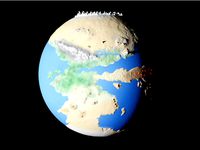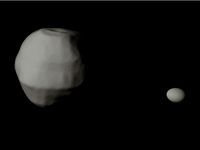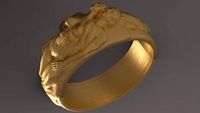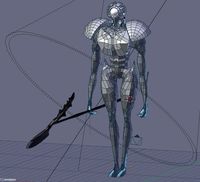Thingiverse

M87* photon ring scaled one in 1.5*10^15 by tato_713
by Thingiverse
Last crawled date: 2 years, 11 months ago
This is a representation of the intensity of the light emitted from around the central black hole of the galaxy M87 (named M87*). I made this using MATLAB R2020a and the images from Arras (2020), images derived from the famous images from the Event Horizon Telescope Collaboration (2019), the first "direct" images taken of a black hole ever. The original image is extremely blurred because of its short apparent diameter (angle of view). In order to get the scale, is about the same apparent size of watching a smartphone on the surface of the Moon, from Earth. This was posible using telescopes all around the globe as a giant interferometer. There are also distortion because of the gravitational lensing, and the material present there is constantly moving. I use the "day 0" of the mentioned paper, and I made correction for the gravitational lensing, simulating the path of light around the black hole. The shadow of the black hole was also compensated. I simulate the orbit of the material around for 4 days, just to give the model a "whirlpool" looking. I have to clarify that non feature shown in the model have a real correlation, the material there is orbiting in a thin flat disc around, and from 3 times the Schwarzschild radius beyond. The main brilliant ring is the photon ring, composed of photons orbiting at the speed of light, ionizing and spiralling inside the event horizon. I used Blender to smooth the borders of the disc. The part you see in the original image is the "south" side of disc. That's because of its spin direction and the right hand rule, the south direction of the rotational axis is pointing almost directly to us.
The file's names explained: name_1_x_10_y.stl is 1 : x * 10y. So _1_6_10_7 is 1:600000000 or one in 60 million.
M87*
M87, or Messier object 87, is one of the biggest galaxies in the local universe, and so it is its central supermassive black. The galaxy is shaped symmetrically spherical, unlike our Milky Way, that has spiral arms instead. The very core of it has a SMBH, where emerge a jet of plasma at relativistic speed, that points near to our direction, 17° to the line of sight. The SMBH event horizon is so big that all the Solar System planets with their orbits fit inside; and it is the second largest event horizon in apparent diameter, that is, the size we see it from here. Te first event horizon in that rank is Sgr A*, Milky Way's core SMBH, because of its proximity to Earth, but Sgr A* is actually way smaller than M87*. The area represented in this model is comparable in size with our Solar System Heliosphere. A black hole whole mass is concentrated in its center, the singularity, but it's common to use the volume of the event horizon as the black hole's volume. The event horizon is not a solid surface, but a boundary from where light can no longer escape. In stellar mass black holes, the event horizon, like Cygnus X-1, have a radius, called "Schwarzschild radius", of a few tens to hundreds kilometers, comparable with a medium size asteroid, resulting in a density over billions times that of water. In contrast, super masive black holes can have a density similar or even lower than water. This is because the Schwarzschild radius is proportional to the mass, and thus, the volume grows by exponent 3 over the mass.
Type: Black hole.
Distance to the Sun: 10.638x107 ly.
Density: Infinite (singularity), 0.0004 g/cm3 (event horizon)
Model scale: 1:1.5x1015 (20cm)
References
Visible shapes of black holesM87* and SgrA. Dokuchaev. 2020
The variable shadow of M87*. Arras. 2020
First M87 Event Horizon Telescope Results. I. The Shadow of the Supermassive Black Hole. The Event Horizon Telescope Collaboration. 2019
Surf to STL function for MATLAB Other astronomical objects
Object
Scale [1:x]
K = 103 (thousand)M = 106 (million)G = 109 (billion)
Image
Inner Solar System
Mercury
20M, 60M,
120M
Venus
60M,
120M,
250M
Earth
60M,
120M,
250M
Luna
10M, 20M,
60M
Mars
20M, 60M,
120M
Phobos and Deimos
200K,
500K
Artificial
Salyut 7
40, 48, 80, 160
Near Earth Asteroids
Moshup and Squannit
8K,
20K,
40K
Ra-Shalom
20K,
40K
Castalia
8K,
20K,
40K
Bacchus
8K,
20K
Bennu
3K,
8K
Ryugu
3K, 8K,
20K
Geographos
40K,
80K
Phaethon
40K,
80K
Itokawa
3K,
8K
Eros
80K, 200K,
500K
Nereus
3K,
8K
Mithra
20K,
40K
Golevka
8K
Toutatis
40K,
80K
Main Asteroid Belt
Gaspra
200K
Annefrank
40K,
80K
Braille
20K,
40K
Vesta
2M, 4M,
10M
Šteins
40K,
80K,
200K
Iris
2M,
4M
Hebe
1M,
2M,
4M
Lutetia
500K, 1M,
2M
Julia
1M,
2M,
4M
Mathilde
500K,
1M
Juno
2M,
4M
Ceres
4M,
10M
Pallas
4M,
10M
Kleopatra
2M,
4M
Ida
500K,
1M
Psyche
2M,
4M
Interamnia
2M,
4M
Hygiea
2M,
4M,
10M
Antiope
1M,
2M
Jovian System
Jupiter
500M, 1G
Amalthea
2M,
4M
Thebe
1M,
2M
Io
20M,
60M
Europa
20M,
60M
Ganymede
60M,
120M
Callisto
60M,
120M
Saturn System
Saturn
500M,
1G
Pan, Daphnis and Atlas
80K,
200K,
500K,
1M
Prometheus and Pandora
1M,
2M
Janus and Epimetheus
2M,
4M
Mimas
2M,
4M,
10M
Methone, Anthe and Pallene
40K,
80K
Enceladus
4M,
10M
Tethys
4M, 10M, 20M
Telesto and Calypso
200K,
500K
Dione
4M, 10M, 20M
Helene
500K,
1M
Rhea
10M,
20M
Titan
60M,
120M
Hyperion
2M,
4M
Iapetus
10M,
20M
Phoebe
1M, 2M,
4M
Uranian System
Uranus
250M,
500M,
1G
Puck
1M,
2M,
4M
Miranda
4M,
10M
Ariel
10M, 20M
Umbriel
10M, 20M
Titania
10M,
20M
Oberon
10M,
20M
Neptunian System
Neptune
250M,
500M,
1G
Larissa
2M,
4M
Proteus
2M,
4M,
10M
Triton
20M
Comets
Tempel 1
40K,
80K,
200K
Wild 2
40K,
80K
Churyumov-Gerasimenko
20K, 40K,
80K
Hartley 2
20K,
40K,
80K
Borrelly
40K,
80K,
200K
Halley
80K,
200K
Centaurs and TNOs
Hidalgo
500K, 1M
Chariklo
2M,
4M
Pluto and Charon
10M,
20M
Styx, Nix, Kerberos and Hydra
500K,
1M
Haumea, Namaka and Hiʻiaka
10M,
20M
Arrokoth
200K,
500K,
1M
Largest TNOs and their moons
10M,
20M
Extrasolar
Exoplanets
120M,
250M,
500M
Nearest white dwarfs
120M,
250M
HD 189733 b
1G
Pulsars
200K,
500K
Cygnus X-1 accretion disk
10M,
20M
M87* photon ring
1.5*1014
Sky maps
Heliosphere
7.5*1013, 1.5*1014
Constellations
-
CMBR
2*1028
Ancient
Earth (540 Mya to 20 Mya)
60M,
120M,
250M
Luna (4 Gya)
20M,
60M
Speculative
Planet Nine
250M,
500M
Cube planet
60M,
120M,
250M
Science Fiction
Ghroth
4M,
10M
Arda
60M,
120M
B612
10, 20, 32, 40
Mesklin
500M,
1G
Arrakis
60M,
120M
Borg cube
8K, 20K,
40K
Pern
60M,
120M
Europa Monolith
200K,
500K
Leonora Christine
500, 600, 1K, 3K
Rama
80K, 200K, 500K
Death Star
500K, 1M, 2M
Starkiller Base
2M, 4M,
10M
Nirn, Secunda and Masser
20M,
60M,
120M
Independence Day mothership
2M,
4M,
10M
Arrival heptapod spaceship
1K,
3K,
8K
Gaijin flowership
3K
Red Moon
60M,
120M
Halo Array
4M,
10M, 20M, 60M
Gem Homeworld
120M, 250M, 500M
The Skeld
40, 80, 160, 350, 500
Misc
Mars (1962 reconstruction)
60M,
120M
Flat Earth
250M
Expanding Earth
60M, 120M
Spaceship of Ezekiel
80, 160
The file's names explained: name_1_x_10_y.stl is 1 : x * 10y. So _1_6_10_7 is 1:600000000 or one in 60 million.
M87*
M87, or Messier object 87, is one of the biggest galaxies in the local universe, and so it is its central supermassive black. The galaxy is shaped symmetrically spherical, unlike our Milky Way, that has spiral arms instead. The very core of it has a SMBH, where emerge a jet of plasma at relativistic speed, that points near to our direction, 17° to the line of sight. The SMBH event horizon is so big that all the Solar System planets with their orbits fit inside; and it is the second largest event horizon in apparent diameter, that is, the size we see it from here. Te first event horizon in that rank is Sgr A*, Milky Way's core SMBH, because of its proximity to Earth, but Sgr A* is actually way smaller than M87*. The area represented in this model is comparable in size with our Solar System Heliosphere. A black hole whole mass is concentrated in its center, the singularity, but it's common to use the volume of the event horizon as the black hole's volume. The event horizon is not a solid surface, but a boundary from where light can no longer escape. In stellar mass black holes, the event horizon, like Cygnus X-1, have a radius, called "Schwarzschild radius", of a few tens to hundreds kilometers, comparable with a medium size asteroid, resulting in a density over billions times that of water. In contrast, super masive black holes can have a density similar or even lower than water. This is because the Schwarzschild radius is proportional to the mass, and thus, the volume grows by exponent 3 over the mass.
Type: Black hole.
Distance to the Sun: 10.638x107 ly.
Density: Infinite (singularity), 0.0004 g/cm3 (event horizon)
Model scale: 1:1.5x1015 (20cm)
References
Visible shapes of black holesM87* and SgrA. Dokuchaev. 2020
The variable shadow of M87*. Arras. 2020
First M87 Event Horizon Telescope Results. I. The Shadow of the Supermassive Black Hole. The Event Horizon Telescope Collaboration. 2019
Surf to STL function for MATLAB Other astronomical objects
Object
Scale [1:x]
K = 103 (thousand)M = 106 (million)G = 109 (billion)
Image
Inner Solar System
Mercury
20M, 60M,
120M
Venus
60M,
120M,
250M
Earth
60M,
120M,
250M
Luna
10M, 20M,
60M
Mars
20M, 60M,
120M
Phobos and Deimos
200K,
500K
Artificial
Salyut 7
40, 48, 80, 160
Near Earth Asteroids
Moshup and Squannit
8K,
20K,
40K
Ra-Shalom
20K,
40K
Castalia
8K,
20K,
40K
Bacchus
8K,
20K
Bennu
3K,
8K
Ryugu
3K, 8K,
20K
Geographos
40K,
80K
Phaethon
40K,
80K
Itokawa
3K,
8K
Eros
80K, 200K,
500K
Nereus
3K,
8K
Mithra
20K,
40K
Golevka
8K
Toutatis
40K,
80K
Main Asteroid Belt
Gaspra
200K
Annefrank
40K,
80K
Braille
20K,
40K
Vesta
2M, 4M,
10M
Šteins
40K,
80K,
200K
Iris
2M,
4M
Hebe
1M,
2M,
4M
Lutetia
500K, 1M,
2M
Julia
1M,
2M,
4M
Mathilde
500K,
1M
Juno
2M,
4M
Ceres
4M,
10M
Pallas
4M,
10M
Kleopatra
2M,
4M
Ida
500K,
1M
Psyche
2M,
4M
Interamnia
2M,
4M
Hygiea
2M,
4M,
10M
Antiope
1M,
2M
Jovian System
Jupiter
500M, 1G
Amalthea
2M,
4M
Thebe
1M,
2M
Io
20M,
60M
Europa
20M,
60M
Ganymede
60M,
120M
Callisto
60M,
120M
Saturn System
Saturn
500M,
1G
Pan, Daphnis and Atlas
80K,
200K,
500K,
1M
Prometheus and Pandora
1M,
2M
Janus and Epimetheus
2M,
4M
Mimas
2M,
4M,
10M
Methone, Anthe and Pallene
40K,
80K
Enceladus
4M,
10M
Tethys
4M, 10M, 20M
Telesto and Calypso
200K,
500K
Dione
4M, 10M, 20M
Helene
500K,
1M
Rhea
10M,
20M
Titan
60M,
120M
Hyperion
2M,
4M
Iapetus
10M,
20M
Phoebe
1M, 2M,
4M
Uranian System
Uranus
250M,
500M,
1G
Puck
1M,
2M,
4M
Miranda
4M,
10M
Ariel
10M, 20M
Umbriel
10M, 20M
Titania
10M,
20M
Oberon
10M,
20M
Neptunian System
Neptune
250M,
500M,
1G
Larissa
2M,
4M
Proteus
2M,
4M,
10M
Triton
20M
Comets
Tempel 1
40K,
80K,
200K
Wild 2
40K,
80K
Churyumov-Gerasimenko
20K, 40K,
80K
Hartley 2
20K,
40K,
80K
Borrelly
40K,
80K,
200K
Halley
80K,
200K
Centaurs and TNOs
Hidalgo
500K, 1M
Chariklo
2M,
4M
Pluto and Charon
10M,
20M
Styx, Nix, Kerberos and Hydra
500K,
1M
Haumea, Namaka and Hiʻiaka
10M,
20M
Arrokoth
200K,
500K,
1M
Largest TNOs and their moons
10M,
20M
Extrasolar
Exoplanets
120M,
250M,
500M
Nearest white dwarfs
120M,
250M
HD 189733 b
1G
Pulsars
200K,
500K
Cygnus X-1 accretion disk
10M,
20M
M87* photon ring
1.5*1014
Sky maps
Heliosphere
7.5*1013, 1.5*1014
Constellations
-
CMBR
2*1028
Ancient
Earth (540 Mya to 20 Mya)
60M,
120M,
250M
Luna (4 Gya)
20M,
60M
Speculative
Planet Nine
250M,
500M
Cube planet
60M,
120M,
250M
Science Fiction
Ghroth
4M,
10M
Arda
60M,
120M
B612
10, 20, 32, 40
Mesklin
500M,
1G
Arrakis
60M,
120M
Borg cube
8K, 20K,
40K
Pern
60M,
120M
Europa Monolith
200K,
500K
Leonora Christine
500, 600, 1K, 3K
Rama
80K, 200K, 500K
Death Star
500K, 1M, 2M
Starkiller Base
2M, 4M,
10M
Nirn, Secunda and Masser
20M,
60M,
120M
Independence Day mothership
2M,
4M,
10M
Arrival heptapod spaceship
1K,
3K,
8K
Gaijin flowership
3K
Red Moon
60M,
120M
Halo Array
4M,
10M, 20M, 60M
Gem Homeworld
120M, 250M, 500M
The Skeld
40, 80, 160, 350, 500
Misc
Mars (1962 reconstruction)
60M,
120M
Flat Earth
250M
Expanding Earth
60M, 120M
Spaceship of Ezekiel
80, 160
Similar models
thingiverse
free

Wheel of Time Earth scaled one in sixty million by tato_713
...
flat earth
250m
expanding earth
60m, 120m
spaceship of ezekiel
80, 160
thingiverse
free

Visitors mothership scaled one in forty by tato_713
...
flat earth
250m
expanding earth
60m, 120m
spaceship of ezekiel
80, 160
thingiverse
free

4660 Nereus scaled one in eight thousand by tato_713
...
flat earth
250m
expanding earth
60m, 120m
spaceship of ezekiel
80, 160
thingiverse
free

Eternia scaled one in sixty million by tato_713
...
flat earth
250m
expanding earth
60m, 120m
spaceship of ezekiel
80, 160
thingiverse
free

Citadel of Ricks scaled one in 200 thousand by tato_713
...it in the same scale with a city with similar population density, in which the landscapes of the citadel...
thingiverse
free

65803 Didymos and Dimorphos scaled one in eight thousand by tato_713
...
flat earth
250m
expanding earth
60m, 120m
spaceship of ezekiel
80, 160
thingiverse
free

Gaijin flowership scaled one in three thousand by tato_713
...
flat earth
250m
expanding earth
60m, 120m
spaceship of ezekiel
80, 160
thingiverse
free

HD 189733 A b heat map scaled one in one billion by tato_713
...reconstruction)
60m,
120m
flat earth
250m
expanding earth
60m, 120m
thingiverse
free

Spaceship of Ezekiel scaled one in 160 by tato_713
...
flat earth
250m
expanding earth
60m, 120m
spaceship of ezekiel
80, 160
thingiverse
free

Rama scaled one in 500 thousand by tato_713
...
flat earth
250m
expanding earth
60m, 120m
spaceship of ezekiel
80, 160
M87
thingiverse
free

Picatinny 25mm Flashlight Holder by doakley_42
...not all picatinny rails. i'm using mine on my m87 archer. other materials i designed this model to use...
thingiverse
free

Visitors mothership scaled one in forty by tato_713
...pulsars 200k, 500k cygnus x-1 accretion disk 10m, 20m m87 photon ring 1.5*1014 sky maps heliosphere 7.5*1013, 1.5*1014 constellations...
thingiverse
free

Wheel of Time Earth scaled one in sixty million by tato_713
...pulsars 200k, 500k cygnus x-1 accretion disk 10m, 20m m87 photon ring 1.5*1014 sky maps heliosphere 7.5*1013, 1.5*1014 constellations...
thingiverse
free

65803 Didymos and Dimorphos scaled one in eight thousand by tato_713
...pulsars 200k, 500k cygnus x-1 accretion disk 10m, 20m m87 photon ring 1.5*1014 sky maps heliosphere 7.5*1013, 1.5*1014 constellations...
thingiverse
free

Citadel of Ricks scaled one in 200 thousand by tato_713
...pulsars 200k, 500k cygnus x-1 accretion disk 10m, 20m m87 photon ring 1.5*1014 sky maps heliosphere 7.5*1013, 1.5*1014 constellations...
thingiverse
free

Eternia scaled one in sixty million by tato_713
...pulsars 200k, 500k cygnus x-1 accretion disk 10m, 20m m87 photon ring 1.5*1014 sky maps heliosphere 7.5*1013, 1.5*1014 constellations...
cg_trader
$49

M87 Black Hole - Animated full scene
...ted full scene
cg trader
a 3d animated scene made in maya and rendered with arnold representing the supermassive black hole m87.
cg_trader
$5

Realistic Messier-87 Super Massive Black Hole
...as virgo a or ngc 4486, generally abbreviated to m87 is a supergiant elliptical galaxy with several trillion stars...
3dwarehouse
free

Universe: M87
...universe: m87
3dwarehouse
3d m87
Tato
3ddd
$1

Tato 01, IL Loft
... om
стул tato 01 от итальянской компании il loft, размер: 700x500x840
источник: www.illoft.com
материалы в комплекте.
turbosquid
$8

TATO JIL TABLE LAMP
...l table lamp for download as jpg, 3ds, max, dxf, obj, and fbx on turbosquid: 3d models for games, architecture, videos. (1489908)
design_connected
$11

Biba Table Lamp
...biba table lamp designconnected tato italia biba table lamp computer generated 3d model. designed...
design_connected
$11

Jil Table Light
...jil table light designconnected tato italia jil table light computer generated 3d model. designed...
3d_sky
free

Tato 01, IL Loft
...1, il loft
3dsky
chair of the italian company of tato 01 il loft, size: 700x500x840 source: www.illoft.com
materials in the kit.
3dbaza
$3

Tato PIEDI REGOLABILI TABLE BY IGNAZIO GARDELLA (123600)
...tato piedi regolabili table by ignazio gardella (123600)
3dbaza
tato piedi regolabili by ignazio gardella table 3d model
thingiverse
free

Tato Cube 3 / Cube3 Extruder Original Hobbed & 608 Bearing by mdorignac
...ruder original hobbed & 608 bearing by mdorignac
thingiverse
tato cube 3 / cube3 extruder original hobbed & 608 bearing
thingiverse
free

Couch Phone-tato by mmarcoux98
... ability.
finally do let me know of other compatible phones and phones you would like a couch phone-tato for.
thanks and enjoy!
3dbaza
$3

Wallie Chandelier by Lorenza Bozzoli for Tato (137297)
... 928<br>xform: no<br>box trick: no<br>model parts: 2<br>render: v-ray<br>formats: 3ds max 2014, obj
3dbaza
$3

Anita Table Lamp by Lorenza Bozzoli for Tato (137153)
... 960<br>xform: no<br>box trick: no<br>model parts: 2<br>render: v-ray<br>formats: 3ds max 2014, obj
713
design_connected
$11

713
...713
designconnected
cassina 713 coffee tables computer generated 3d model. designed by theodore waddell.
turbosquid
free

glider PH-713
... available on turbo squid, the world's leading provider of digital 3d models for visualization, films, television, and games.
3ddd
free

Italamp fashion lighting 713
...13
3ddd
italamp , fashion
люстра - italamp fashion lighting 713
размеры - d60 см, h29 см
3ddd
$1

N-Light 713-03-52AC Antique Copper/713-03-12CH Polished Nickel
...ch polished nickel
3ddd
подвес
подвес в корабельном стиле
713-03-52ac antique copper n-light
713-03-12ch polished nickel n-light
3ddd
$1

tisserant as-713
...ch's , tisserant
3ds max 2014
3ds max 2011
fbx
obj
textures
materials
real size
3d_export
$60

Architecture 713 3D Model
...lege campus max street landscape commercial building medical hospital offices
architecture 713 3d model lotusmodel 49098 3dexport
3d_export
$150

3d building 713 3D Model
...erior vray sitting accesorie apartment home visualization sofa couch table chair
3d building 713 3d model kanhtart 46553 3dexport
3ddd
$1

NLight 713-03-52AC
...light , подвес
потолочная чаша - с шарниром.
внизу плафона - матовое рассеивающее стекло
3d_export
$50

3D Home 713 3D Model
... chair furniture texture table lamp apartment rug carpet restaurant hotel sitting
3d home 713 3d model richard3015 46995 3dexport
humster3d
$40

3D model of Acer Iconia Tab 7 (A1-713)
...d 3d model of acer iconia tab 7 (a1-713) in various file formats. all our 3d models were created maximally close to the original.
Photon
3d_export
$7

swimming pool waterfall
...caustics<br>-disable the vraymtl's affect shadows parameter when using caustics.<br>-set photon emit radius (v-ray sun)<br>-increase caustics subvids (vray properties >...
3d_sky
$8

PHOTON
...photon
3dsky
wall lamp table lamp floor lamp
photon
3d_sky
free

PHOTON
...photon
3dsky
wall lamp table lamp floor lamp
photon factory
thingiverse
free

Photons
...photons
thingiverse
my last test before i print real things.
files come with the anycubic photon s
thingiverse
free

knocker for photon by Mckymn2000
...hoton by mckymn2000
thingiverse
was redon for photon you wont the 4kcnoker for photon
https://www.thingiverse.com/thing:1458545
thingiverse
free

Antimatter Photon Fin
...antimatter photon fin
thingiverse
antimatter photon fin, dieborr fpv style.
3d_sky
free

PHOTON
...photon
3dsky
chandelier lamp light floor lamp
chandelier table lamp and floor lamp from the factory "foton"
thingiverse
free

Photon Torpedoes by Mike1701
...photon torpedoes by mike1701
thingiverse
star trek's primary means of blowing the crap out of something, the photon torpedo.
thingiverse
free

Anycubic Photon Door Holder
...anycubic photon door holder
thingiverse
anycubic photon door holder
thingiverse
free

Particle Photon Case by mpleander
...particle photon case by mpleander
thingiverse
case for particle photon iot device.
15
3d_export
$5

Iphone 15
...iphone 15
3dexport
apple iphone 15
3ddd
$1

Bed 15
...bed 15
3ddd
постельное белье
bed 15
design_connected
$13

Ella 15
...ella 15
designconnected
delightfull ella 15 computer generated 3d model.
design_connected
$27

Kilt 15
...kilt 15
designconnected
zanotta kilt 15 computer generated 3d model. designed by progetti, emaf.
design_connected
$22

Domino 15
...domino 15
designconnected
zanotta domino 15 computer generated 3d model. designed by progetti, emaf.
design_connected
$9

SMTV 15
...smtv 15
designconnected
maxalto smtv 15 computer generated 3d model. designed by citterio, antonio.
design_connected
$25

Docks 15
...docks 15
designconnected
gandia blasco docks 15 computer generated 3d model. designed by romero vallejo.
design_connected
$7

Bolla 15
...bolla 15
designconnected
gervasoni bolla 15 coffee tables computer generated 3d model. designed by michael sodeau.
3ddd
$1

Curtains 15
...curtains 15
3ddd
curtains 15
polys: 331066
other models:http://3ddd.ru/users/brast/models
3d_export
$6

tap-15
...tap-15
3dexport
10
turbosquid
$25

10
... available on turbo squid, the world's leading provider of digital 3d models for visualization, films, television, and games.
turbosquid
$10

a-10
... available on turbo squid, the world's leading provider of digital 3d models for visualization, films, television, and games.
3ddd
$1

EX 10
...ex 10
3ddd
samsung , фотоаппарат
ex 10
3ddd
$1

Bed 10
...bed 10
3ddd
постельное белье
bed 10
evermotion
$25

Scene 10 Archinteriors vol. 10
...dering design interior
take a look at textured and shadered visualization scene ready to be rendered.. evermotion 3d models shop.
3ddd
$1

Curtains 10
...curtains 10
3ddd
curtains 10
3ds max 2011,fbx + textures
polys: 100355
3ddd
free

PLANTS 10
...plants 10
3ddd
цветок , горшок
plants 10,, with 3 different color planter boxes
design_connected
$29

Nuvola 10
...nuvola 10
designconnected
gervasoni nuvola 10 computer generated 3d model. designed by navone, paola.
design_connected
$22

Kilt 10
...kilt 10
designconnected
zanotta kilt 10 computer generated 3d model. designed by progetti, emaf.
design_connected
$11

Domino 10
...domino 10
designconnected
zanotta domino 10 computer generated 3d model. designed by progetti, emaf.
Scaled
turbosquid
$40

Scale
... available on turbo squid, the world's leading provider of digital 3d models for visualization, films, television, and games.
turbosquid
$12

Scale
... available on turbo squid, the world's leading provider of digital 3d models for visualization, films, television, and games.
turbosquid
free

Scale
... available on turbo squid, the world's leading provider of digital 3d models for visualization, films, television, and games.
3d_export
$7

of scales
...s have a flat point of support. the samples are rendered in the standard cinema 4d renderer. enjoy your use and creative success.
3d_export
$5

scale knob
...scale knob
3dexport
scale knob
3d_export
$20

cartoon weight scale or bathroom scale
...cartoon weight scale or bathroom scale
3dexport
texture size:512px number of texture:1 texture format: png
3d_ocean
$4

Bathroom scale
... the model is ready to import and render in all formats. it comes with a .tif diffuse texture. for other cool stuff check out ...
3d_export
free

scales 3
...scales 3
3dexport
3d_export
$10

ruller scale
...ere 4 types of formats are attached with texture, i.e. the original size of the scale with stl printable file is 30 cm in length!
turbosquid
$26

Scientific Scale
...
royalty free 3d model scientific scale for download as blend on turbosquid: 3d models for games, architecture, videos. (1639609)
5
3d_export
$5

hinge 5
...hinge 5
3dexport
hinge 5
turbosquid
$10

A-5
... available on turbo squid, the world's leading provider of digital 3d models for visualization, films, television, and games.
turbosquid
$2

A-5
... available on turbo squid, the world's leading provider of digital 3d models for visualization, films, television, and games.
turbosquid
$12

Calligraphic Digit 5 Number 5
...hic digit 5 number 5 for download as max, obj, fbx, and blend on turbosquid: 3d models for games, architecture, videos. (1389333)
3ddd
$1

5 роз
...5 роз
3ddd
5 роз в стеклянной вазе
design_connected
$11

iPhone 5
...iphone 5
designconnected
apple iphone 5 computer generated 3d model.
3ddd
$1

Lola 5
...lola 5
3ddd
miniforms
lola 5 miniforms 300*65*134
3ddd
$1

Nexus 5
...dd
nexus , phone , телефон
google nexus 5 phone
3d_ocean
$15

iPhone 5
...iphone 5
3docean
3d 4d apple cinema iphone model modeling phone screen texture
iphone 5 3d model and texture realistic iphone 5.
3d_ocean
$9

chanel 5
...chanel 5
3docean
books chanel
quality models perfum chanel 5 and books.
Ring
3d_export
$5

ring
...ring
3dexport
ring
3d_export
free

ring
...ring
3dexport
ring
3d_export
free

ring
...ring
3dexport
ring
3d_export
free

ring
...ring
3dexport
ring
3d_export
$10

ring
...ring
3dexport
lord of the rings
3d_export
$5

ring
...ring
3dexport
golden ring
3d_export
free

ring
...ring
3dexport
cherub ring
3d_export
$10

ring
...ring
3dexport
3d ring model
3d_export
$5

ring
...ring
3dexport
ring 3d model
3d_export
$5

ring
...ring
3dexport
ring top black...
One
turbosquid
$2

one plus one
... available on turbo squid, the world's leading provider of digital 3d models for visualization, films, television, and games.
3ddd
$1

One
...one
3ddd
стул
офисный стул one
3ddd
free

one
...
palazetti one ,http://palazzetti.ca/index.php/component/virtuemart/seating/armchairs-lounges/one-chair-detail?itemid=0
turbosquid
$35

One A
... available on turbo squid, the world's leading provider of digital 3d models for visualization, films, television, and games.
turbosquid
free

One
... available on turbo squid, the world's leading provider of digital 3d models for visualization, films, television, and games.
3ddd
$1

Стул One
...стул one
3ddd
one , magis
кресло magis s.p.a , one
3ddd
$1

Стул One
...стул one
3ddd
one , magis
кресло one chair (4star), magis s.p.a.
3d_export
$20

xbox one
...xbox one
3dexport
xbox one
3ddd
$1

xbox one
... консоль , джойстик
xbox one + kinect + gamepad
3ddd
free

One
...nstantin grcic
артикул ct-284 (cosmorelax.ru)
размер l36xw41xh82.5, sh 77cm
цвет черный, красный
материал алюминий
вес 2,5 кг
1
turbosquid
$15

ring 1+1
... available on turbo squid, the world's leading provider of digital 3d models for visualization, films, television, and games.
turbosquid
$10

chair(1)(1)
... available on turbo squid, the world's leading provider of digital 3d models for visualization, films, television, and games.
turbosquid
$8

Chair(1)(1)
... available on turbo squid, the world's leading provider of digital 3d models for visualization, films, television, and games.
turbosquid
$2

RING 1(1)
... available on turbo squid, the world's leading provider of digital 3d models for visualization, films, television, and games.
turbosquid
$1

Table 1(1)
... available on turbo squid, the world's leading provider of digital 3d models for visualization, films, television, and games.
turbosquid
$1

house 1(1)
... available on turbo squid, the world's leading provider of digital 3d models for visualization, films, television, and games.
design_connected
$11

No 1
...no 1
designconnected
sibast no 1 computer generated 3d model. designed by sibast, helge.
turbosquid
$50

door 1 darkwood 1
... available on turbo squid, the world's leading provider of digital 3d models for visualization, films, television, and games.
turbosquid
$15

Barrel Barricade 1-1
... available on turbo squid, the world's leading provider of digital 3d models for visualization, films, television, and games.
turbosquid
$15

Door Lock(1)(1)
... available on turbo squid, the world's leading provider of digital 3d models for visualization, films, television, and games.
